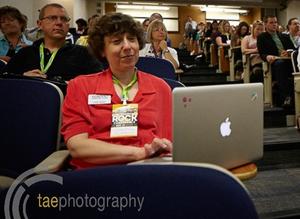Though blogging is a form of social media, many business owners jump onto Twitter, Facebook or LinkedIn long before they even consider blogging. And while it seems as though it will be easier to write a 140-character tweet than a 500-word blog post, the most common concern I hear about social media is, “I never know what to say!”
I often use the expression that blogging is what turns social networking into business networking. Blog posts demonstrate your expertise and tell your story to the people in your social networks. You can accomplish this with various types of content, from “how to” articles, to industry observations, to behind-the-scenes tours of your business.

At last week’s Tweetstock 8 conference in Brantford, Ontario, I heard many examples of blogging as a component of effective social media marketing.
Here are five reasons to blog before you tweet:
- Blogging helps you to be more useful. Mitch Joel spoke about the urgent need for “utility” and how businesses must put out content that’s useful, rather than purely promotional or biographical. When you blog about topics that interest your customers, you provide value. You can then share that value via social media with teasers and links back to your blog.
- Blogging helps you build a community of like-minded people. In his presentation about business networking strategies, Dave Delaney pointed out that when like-minded people meet, great things happen. Blogging expands on your social media profiles to help both customers and colleagues learn more about you – as a business and as the people behind the business. Just be sure to write authentically and express your unique views and opinions.
- Blogging helps you listen to your community. Rebecca Harris took us behind the scenes of the social media command centre at GM, where staff monitor all of GM’s social media channels as well as more than 90 car enthusiast forums. When you share your blog posts on social media, you’ll get an enormous amount of feedback about what was and wasn’t useful. You’ll also get plenty of ideas for your future blog posts.
- Blogging starts a discussion with your community. According to Mitch Joel, social media is there to help facilitate real interactions between human beings. Whether people have posted a comment at your blog, or shared or endorsed your post via social media, respond as quickly as possible to show your appreciation and build that relationship. When your company has made a mistake or received negative feedback, a prompt response is even more important. Rebecca Harris illustrated this with the example of a GM ad that was pulled after people voiced complaints on social media.
- Blogging can have a profound impact – both on your readers and yourself. Concerned that you’re repeating yourself on your blog, or convinced that your information is common knowledge? Remember that there is someone out there who has never heard your message. John Morgan reminded us that you never know whose lives you’ve changed – when you’ve said exactly what someone needs to hear. As for what blogging does for the blogger, Mitch Joel noted that it allows us to continually explore and develop new ideas, and to keep learning.
So if you’ve been struggling to add to the conversation on social media, consider starting a business blog!
Photos courtesy of Tae McIntosh of Tae Photography.
P.S. I was just as inspired by the other Tweestock 8 presenters (I was tweeting all day long!):

- C.C Chapman, author of Amazing Things Will Happen and co-author of Content Rules. C.C.’s closing remarks to the group were that you should trust your gut. If something feels wrong, listen. If it feels right, make it happen.
- Matteo Wyllyamz (mouselink), who spoke about the trends of technological culture. He implored us to be open to new future trends, and to opt for agility rather than loyalty.
- Karen Schulman Dupuis, Manager, Digital Communications, MaRS Discovery District, who spoke about small business innovation and opened our eyes to the many resources available to Ontario businesses.
 This is the third post in a three-part series about building online and offline relationships. In Part One we discussed
This is the third post in a three-part series about building online and offline relationships. In Part One we discussed 





